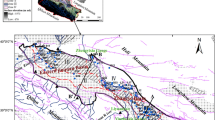Abstract
Groundwater level fluctuations and trends can be used to estimate changes in aquifer storage resulting from the effects of groundwater withdrawal and recharge. These data can be used to address water management needs and to evaluate the effects of management and conservation programs. The study was divided in two periods; 1997 to 2006 — the Phase 1 and 2007 to 2016 — the Phase 2. Though the significant decline in average water levels, both in pre-monsoon and post-monsoon, were observed from Phase 1 to Phase 2 but the rate of decline in water level was not only checked from 0.102 m/yr (Phase 1) to rise at 0.056 m/yr (Phase 2) in pre monsoon season. In post monsoon season this became more prominent as decline rate of 0.308 m/yr in Phase 1 changes to rise in water level at 0.101 m/yr during Phase 2. This trend may be attributed to the construction of water conservation structures.
Similar content being viewed by others
References
Adhikari, R.N., Singh, A.K., Math, S.K.N., Sharma, K.K. and Reddy, K.K. (2015) Study on the effect of groundwater recharge through water harvesting structures in semi-arid red soil region of south India. Indian Jour. Soil Conservation. v.43(3), pp.266–270.
Bouwer Herman (2002) Artificial recharge of Groundwater: Hydrogeology and engineering. Hydrogeol. Jour., v.10, pp.121–142.
CGWB (1994) Artificial ground water recharge with a special reference to India. http://cgwb.gov.in/documents/ArtificialRecharge-Guide.pdf
District Ground Water Information Booklet (2013) Ministry of Water Resources. CGWB. North Central Region, Bhopal, Madhya Pradesh. Govt. of India. http://cgwb.gov.in/District_ Profile/MP/Tikamgarh.pdf
Manjula, K.R. (2010) Digitizing the Forest Resource Map Using ArcGIS. Internat. Jour. Computer Sci., v.7(6), pp.1694–0814
Naidu, Mohan, G., Statistics. Lecture Notes (STCA-101). Dept. of Statistics & Mathematics. 2013. S.V. Agricultural College Tirupati. Acharya N.G. Ranga Agricultural University.
Patle Deepak, Awasthi, M.K., Sikarwar Pushpendra, Shrivastava R.N., Tiwari, Y.K. (2017) Investigation on water table behaviour in Tikamgarh, Madhya Pradesh. JNKVV Research Jour., v.51(2) pp.168–173.
Snedecor, G.W. (1934) Calculation and interpretation of analysis of variance and Covariance. Collegiate Press. Ames, Iowa. A Google Book.
Thakur, G.S. and Thomas, T. (2011) Analysis of Groundwater Levels for Detection of Trend in Sagar District, Madhya Pradesh. Jour. Geol. Soc. India, v.77 pp.303–308
Toposheets of Tikamgarh district, Madhya Pradesh. Survey of India. Nakshe Portal. http://www.soinakshe.uk.gov.in/searchbygeodata.aspx
Author information
Authors and Affiliations
Corresponding author
Rights and permissions
About this article
Cite this article
Patle, D., Awasthi, M.K. Past Two Decadal Groundwater Level Study in Tikamgarh District of Bundelkhand. J Geol Soc India 94, 416–418 (2019). https://doi.org/10.1007/s12594-019-1330-6
Received:
Accepted:
Published:
Issue Date:
DOI: https://doi.org/10.1007/s12594-019-1330-6




